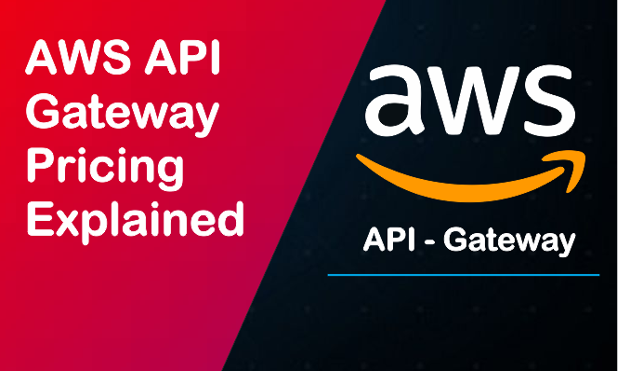
AWS API Gateway pricing: Factors and Cost Structure
With AWS API Gateway pricing, you pay only when your APIs are being utilized. Amazon does not require any advance payments or minimum costs.
You may prepare and manage your API Gateway intake by finding the AWS API Gateway pricing details. The application programming interface (API) gateways are part of the foundations of microservices and serverless architectures.
An all-inclusive solution for creating, implementing, and maintaining API is offered by AWS API Gateway. It offers scalability, security, integration capabilities, and developer-friendly features, making it a popular choice for organizations that want to publish their services in the form of APIs in a secure and scalable way.
Each type of API in the Amazon API Gateway supports various use cases and provides particular capabilities and functionalities. RESTful APIs are best suited for standard REST-based web services, while WebSocket APIs are best suited for real-time applications and HTTP APIs are a lightweight solution for serverless architectures.
Let’s continue to the topic of the Ultimate Guide to AWS API Gateway Pricing:
AWS API Gateway Pricing Explained

What is an AWS API Gateway? | What is Amazon API Gateway?
AWS API Gateway is a fully managed service provided by Amazon Web Services (AWS) that allows developers to construct, release, and maintain APIs (Application Programming Interfaces) for their applications.
As an API front door, it enables developers to securely and conveniently expose their backend services as APIs to different clients, such as web applications, mobile apps, or other AWS services.

You may use authentication and rate-limiting features to protect your APIs from fraud or misuse while hosting large-scale APIs. We can monetize your API by using analytics and monitoring tools to display how users interact with it visually.
API Gateway creates RESTful APIs:
- Are HTTP-based.
- Enable stateless client-server communication.
- Implement standard HTTP methods such as GET, POT, PUT, PATCH, and DELETE.
Select * FROM test
Why do we use the AWS API gateway?
AWS API Gateway is used for the following reasons:
- API management: It provides a centralized platform for creating, deploying, and managing APIs, making API development and maintenance easier. Managing APIs can all be done from one place with the help of AWS API Gateway. To design devices, methods, request/response models, and authentication techniques, it provides a user-friendly interface. This streamlines the creation and configuration of APIs.
- Scalability and high availability: API Gateway includes capabilities like caching to improve efficiency while scaling automatically to manage a large amount of traffic.
- Security: API Gateway provides strong security programs to protect your APIs. It is flexible with several techniques for authentication, including API keys, AWS Identity and Access Management roles, and private authorizers. You may also specify advanced access control and request/response transformation rules to improve the security of your APIs.
- Monitoring and analytics: It offers thorough tracking as well as monitoring features that help developers maintain track of API usage, performance indicators, and failures. You may learn more about how your APIs are being used, solve problems, and enhance performance.
- Developer-friendly features: It supports multiple programming languages, frameworks, and development tools. API Gateway supports a variety of programming languages and provides tools for API documentation, SDK development, and testing, all of which improve the developer experience.
- Cost optimization: Thanks to API Gateway’s adjustable usage-based pricing, businesses may cut costs by only paying for actual API usage.
- Support for Serverless Architecture: API Gateway’s easy integration with AWS Lambda allows it possible to build Serverless Architectures. It enables Lambda function direct integration, making it simple to run business logic during API processing.
What API types are supported by Amazon API Gateway?

Three different types of APIs are supported by Amazon API Gateway:
- RESTful APIs: RESTful APIs follow the term representational State Transfer (REST) architecture’s guidelines. To interface with resources and conduct activities, they use HTTP methods like GET, POST, PUT, DELETE, and more. You can define endpoints, methods, request/response models, query parameters, headers, and more for creating RESTful APIs using API Gateway.
- WebSocket APIs: WebSocket APIs allow clients and servers to communicate in real-time and in both directions. With WebSocket APIs, you may create endless connections that support full-duplex communication, allowing data to be sent and received at the same time. This is very helpful for programs like chat programs, teamwork tools, and gaming programs that demand real-time updates.
- HTTP APIs: HTTP APIs are a more portable and cost-effective alternative to RESTful APIs. They offer an easier method for building APIs with less cost and better performance. HTTP APIs provide capabilities like JWT authorizers, CORS (Cross-Origin Resource Sharing) management, easy deployment, and smooth connection with AWS Lambda functions and are optimized for developing serverless apps.
AWS API Gateway pricing | AWS API Pricing
API Gateway offers a free plan for the first 12 months. When this 12-month period expires or your application is used over the stages, you will only be charged at standard rates.
The cost of AWS API Gateway pricing depends on several factors, including request volume, data transfer, Caching, and regional data transfer. By understanding the pricing model, you can assess the costs associated with using the AWS API Gateway.
Understanding AWS API Gateway pricing information can help you plan and budget for your API
Request Volume:
AWS charges are based on the number of requests sent to your API Gateway. This includes all API calls and data transfers. Pricing varies depending on the number of requests, and you will be compensated accordingly.
HTTP APIs
Pay only for the API calls you receive and the data which is transferred outside. For HTTP APIs, the API Gateway free plan provides one million API calls every month for a period of one year. After a million calls, you have to pay some fees to use it.
APIs call rate for US West (Northern California)
| HTTP APIs | API Calls | Number of Requests (per month) | Price (per million) |
| First 300 million | $1.17 | ||
| 300+ million | $1.05 |
REST APIs:
In the US West (Northern California) region, the current pricing for REST APIs depends on the quantity of API calls received.
| REST APIs | API Calls | Number of Requests (per month) | Price (per million) |
| First 333 million | $3.50 | ||
| Next 667 million | $3.47 | ||
| Next 19 billion | $2.95 | ||
| Over 20 billion | $1.87 |
WebSocket APIs Pricing
The cost of using WebSocket APIs is calculated according to the total amount of connection minutes and the number of messages delivered and received. Messages are metered in 32 KB increments, so for example, 33 KB is metered as two requests.
Message Transfer rate for US West (Northern California)
| Message Transfers | Number of Requests (per month) | Price (per million) |
| First 1 billion | $1.24 | |
| Over 1 billion | $1.04 |
Cache Pricing:
AWS API Gateway allows you to enable caching for your APIs. If you choose to use caching, additional fees may be incurred depending on the cache capacity and the number of caches created. For frequently accessed data, archiving can increase performance by serving stored responses.
| Cache Memory Size (GB) | Price per Hour |
| 0.5 | $0.02 |
| 1.6 | $0.038 |
| 6.1 | $0.20 |
| 13.5 | $0.25 |
| 28.4 | $0.50 |
| 58.2 | $1.00 |
| 118.0 | $1.90 |
| 237.0 | $3.80 |
Data Transfer:
AWS API Gateway pricing includes the cost of data transferred between your API Gateway and customers. This includes both inbound and outbound traffic. Pricing is based on the amount of data transferred and charged accordingly. If you used external data transfers, you will be charged at the EC2 data transfer rate.
EC2 data transfer rate link: https://aws.amazon.com/ec2/pricing/
[su_note note_color=”#ffe434″ text_color=”#000000″]Note: Pricing for AWS services may change over time, and it is recommended that you check the official AWS website or contact AWS support for up-to-date pricing information and it was perfect.[/su_note]
For other countries’ call rates, you can check them from this link https://aws.amazon.com/api-gateway/pricing/
AWS API Gateway Pricing Calculator | AWS Pricing Calculator API
AWS API Gateway pricing depends on the type of API service offered i.e., REST API, HTTP API, and WebSocket API. You can use the AWS pricing calculator on the AWS website to estimate your typical cost of using the AWS API Gateway.
This tool allows you to input your operational requirements and provides estimates of associated costs based on current pricing data.
You can calculate your call rates by using this link https://calculator.aws/#/addService/APIGateway
AWS API Gateway Example
Rest API Calculation
Example: Every month, API receives 33 million requests, with each request providing a response that is 5 kilobytes in size.
| API call charges = API Call Receives in millions * Price = 33 * 3.5 = 115.50 The total size of data transmissions = response data size in kb * API Call Receives in millions = 5 * 33 = 165 GB Data Transfer Charges = The total size of data transmissions * Data transfer rate = 165 GB * 0.09 = $14.85 Total AWS API Gateway charges = API call charges + Data Transfer Charges = $17.50 + $1.29 = $18.79 |
Features AWS API Gateway
- With support for RESTful and WebSocket APIs, it is simple to design, configure, and handle APIs.
- Integration with AWS Services: Connect APIs to a variety of AWS services, including Lambda, DynamoDB, and Step Functions, in an effortless manner.
- Setting up functionality is available for deployment when deploying APIs to different settings or stages.
- Robust authentication techniques, fine-grained access control, and request/response transformation for increased security.
- Built-in caching features to enhance API performance and lighten the burden on the backend.
- Integration with AWS CloudWatch is used for monitoring, metrics, and error logs.
- Create API documentation and SDKs for simplified integration using the developer site and documentation.
- Change and modify requests and responses with payloads by using mapping templates.
- Developing serverless designs becomes simple with the help of AWS Lambda.
Benefits of Amazon API Gateway
The use of Amazon API Gateway has several major benefits:
Cost: Since API Gateway operates on a pay-per-use model, users just pay for the APIs they actually utilize. There are no prior restrictions or required costs.
Fully Managed: API Gateway is a fully managed service, allowing users to focus on creating apps rather than having to handle important services themselves.
FAQs on AWS API Gateway Pricing
Question: How do I get started with Amazon API Gateway?
Answer: You have a few options for getting started, including the Amazon API Gateway console, Amazon CLI, and Amazon SDKs.
Question: Is AWS API Gateway expensive?
Answer: The cost of utilizing Amazon API Gateways can be impacted by a variety of variables, including the volume of requests, the amount of data sent, the amount of caching, and the use of additional services. Although API Gateway isn’t considered to be very costly, it is important to fully analyze your unique pattern of use and requirements to properly evaluate the corresponding costs.
Question: Does API Gateway have minimum fees to startup
Answer: API Gateway has no minimum fees or initial charges. It is also free for the first 12 months.
Question: What is included in the free tier of API Gateway?
AWS offers a free tier for API Gateway, which provides certain usage limits at no cost. The free tier includes 1 million API calls per month for the first 12 months, 1 GB of data transfer out per month for the first 12 months, and 100,000 cache invalidation requests per month for the first 12 months. However, additional charges may apply if you exceed these limits or use features not covered by the free tier.
Question: Is API Gateway a good idea?
Answer: Yes, API Gateway makes sense for several reasons. It provides a centralized platform for designing, deploying, and managing APIs, reducing the API development process.
It provides excellent and high flexibility while automatically managing variable API traffic volumes. It guards APIs against unauthorized access with powerful safety features.
API Gateway works easily with other AWS services, enabling the development of powerful and scalable architectures.
You can track API consumption and enhance performance with its monitoring and analytics features. In addition, it provides features that are developer-friendly and variable price structures, providing an affordable option. All things considered, API Gateway is a trusted and full-featured platform
Conclusion
In this article, we have discussed AWS API Gateway Pricing. We have introduced the AWS API Gateway price, which should help you save money on this service.
I hope after reading this information, people will be able to understand how AWS API Gateway pricing operates and make smart decisions when organizing their API setups, setting a budget, and reducing costs.
In addition to learning about the three distinct types of APIs that are available and how to select one, Amazon API Gateway also learned about cost-tracking and-reduction strategies. You should be able to create your next server less API at a cost-effective level using the knowledge you have today.


